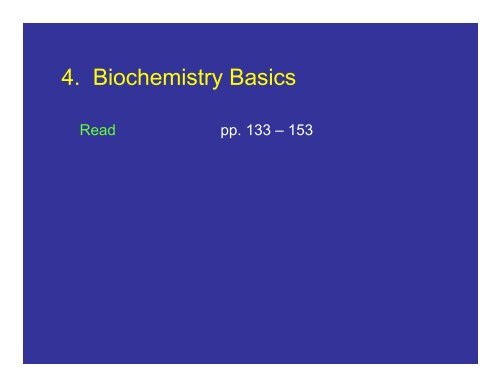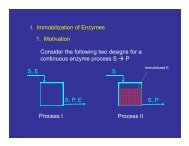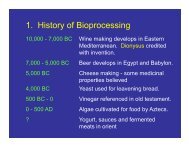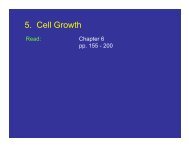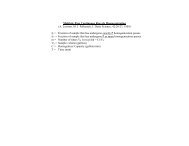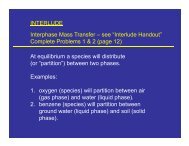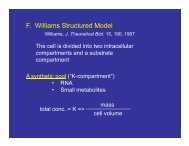Biochemistry - CMBE
Biochemistry - CMBE
Biochemistry - CMBE
You also want an ePaper? Increase the reach of your titles
YUMPU automatically turns print PDFs into web optimized ePapers that Google loves.
4. <strong>Biochemistry</strong> Basics<br />
Read pp. 133 – 153
A. Introduction<br />
Catabolism – degradation of a compound into<br />
smaller and simpler products with the<br />
concomitant generation of energy.<br />
Anabolism – synthesis of more complex<br />
molecules for cellular processes with the<br />
utilization of energy.<br />
Metabolism – catabolism and anabolism.<br />
Currency of biochemistry:<br />
ATP – currency of energy<br />
NADH 2+ – currency of “reducing power”,<br />
electrons or protons.
B. Pathways<br />
1. glycolysis (Embden-Meyerhof-Parnas Pathway)<br />
glucose + 2ADP + 2NAD + + 2Pi <br />
2pyruvate + 2ATP + 2NADH 2<br />
+<br />
Can occur in the absence of oxygen if cells<br />
have mechanism to get rid of NADH 2+ and<br />
ATP generated.<br />
Goal is to break carbohydrates down into<br />
smaller components in “central metabolism”.
2. tricarboxylic acid cycle (Krebs, TCA, citric acid cycle)<br />
pyruvate + NAD + + H-CoA <br />
acetyl-CoA + CO 2 + NADH 2<br />
+<br />
acetyl-CoA + 3NAD + + FAD + GDP + Pi + 2H 2 O <br />
2CO 2 + 3NADH 2+ + FADH 2 + GTP<br />
Can occur in the absence of oxygen if cells<br />
have mechanism to get rid of NADH 2+ , FADH 2<br />
and GTP generated. (Most anaerobes do not<br />
put much carbon through TCA cycle)<br />
Goals are to provide electrons, to produce<br />
chemicals which are used in amino acid (etc.)<br />
synthesis, and to produce some energy.
3. pentose phosphate pathway<br />
3glucose + 6NADP + <br />
2fructose 6-phosphate + glyceraldehyde 3-<br />
phosphate + 6NADPH 2+ + 3CO 2<br />
Can occur in the absence of oxygen if cells<br />
have mechanism to get rid of NADPH 2<br />
+<br />
generated.<br />
Goals are to provide NADPH 2+ used for the<br />
synthesis of biomass and to produce 5-carbon<br />
and 4-carbon compounds.
4. anaplerotic pathways<br />
pyruvate + ATP + HCO 3- <br />
oxaloacetate + ADP<br />
phosphoenolpyruvate + HCO 3- <br />
oxaloacetate + Pi<br />
2acetyl-CoA + 2NAD + + FAD <br />
oxaloacetate + 2NADH 2+ + FADH 2 + 2H-CoA<br />
Can occur in the absence of oxygen.<br />
Goal is to generate intermediates of the TCA<br />
cycle (such as oxaloacetate) which are<br />
withdrawn for the synthesis of biomass.
5. oxidative phosphorylation (electron transport<br />
chain)<br />
This is a membrane bound system of<br />
reactions in which electrons are shuttled<br />
between chemical carriers. The result is:<br />
NADH 2<br />
+<br />
ADP<br />
NAD +<br />
ATP<br />
H +<br />
H +<br />
H +<br />
H +<br />
O 2<br />
H 2 O
5. oxidative phosphorylation (electron transport<br />
chain)<br />
ATP is generated when H + reenters membrane<br />
to balance the concentration gradient. Usually<br />
generate 2-3 ATP per NADH 2<br />
+<br />
Goals are to regenerate reducing power<br />
(NAD + ), produce energy, and to maintain proton<br />
motive force across membrane.
6. summary of principal carbon flow (part 1)<br />
Glycolysis<br />
3C<br />
6C<br />
6C<br />
3C<br />
5C<br />
1C<br />
5C<br />
3C<br />
5C<br />
7C<br />
BIOMASS<br />
1C<br />
3C<br />
4C<br />
4C<br />
Anaplerotic<br />
3C<br />
Pentose Phosphate Pathway
6. summary of principal carbon flow (part 2)<br />
1C<br />
3C<br />
Anaplerotic<br />
3C<br />
2C<br />
1C<br />
4C<br />
4C<br />
6C<br />
5C<br />
1C<br />
BIOMASS<br />
1C<br />
TCA cycle
7. anaerobic metabolism<br />
In the absence of oxygen, cells have two general<br />
approaches to “get rid of” electrons generated in<br />
biochemical pathways:<br />
a) anaerobic respiration – an electron acceptor<br />
different from O 2 is used.<br />
NO 3- NO 2<br />
-<br />
N 2 O N 2
7. anaerobic metabolism<br />
b) fermentation – regeneration of NAD + is<br />
accomplished by conversion of a chemical into a<br />
dead-end product.<br />
pyruvate + NADH 2+ lactate + NAD +<br />
pyruvate + NADH 2+ ethanol + CO 2 + NAD +
8. Calvin-Benson Cycle<br />
Autotrophs use light energy to drive the<br />
conversion of CO 2 into higher carbon<br />
compounds.<br />
a) light phase – produce O 2 , generate NADPH 2+ ,<br />
and generate ATP.<br />
b) dark phase – reduce CO 2 to glucose using<br />
NADPH 2+ and ATP.
C. Calculation of intermediates used<br />
The amount of “flux” through each pathway can be<br />
calculated by knowing the principal carbon source<br />
being consumed and the composition of the cell.<br />
For example, if glucose is the carbon source under<br />
normal conditions, 75-85% of the carbon enters<br />
glycolysis and 15-25% of the carbon enters<br />
pentose phosphate pathway.
Precursor Molecule<br />
Other molecules<br />
Amino Acid Building<br />
Block<br />
Amount Present in E.<br />
coli ( mol/g cells)<br />
acetyl CoA<br />
eythrose 4-P<br />
fructose 6-P<br />
glucose 6-P<br />
a-ketoglutarate<br />
oxaloacetate<br />
Alanine 488 1 1 1<br />
Arginine 281 1 7 -1 4 4<br />
Asparagine 229 1 3 1 2<br />
Aspartate 229 1 1 1<br />
Cysteine 87 1 4 -1 5 1 1<br />
Glutamate 250 1 1 1<br />
Glutamine 250 1 1 1 2<br />
Glycine 582 1 -1 1 -1 1<br />
Histidine 90 1 6 -3 1 1 3<br />
Isoleucine 276 1 1 2 5 1<br />
Leucine 428 1 2 -1 2 1<br />
Lysine 326 1 1 2 4 2<br />
Methionine 146 1 7 8 1 1 1<br />
Phenylalanine 176 1 2 1 2 1<br />
Proline 210 1 1 3 1<br />
Serine 205 1 -1 1 1<br />
Threonine 241 1 2 3 1<br />
Tryptophan 54 1 1 1 5 -2 3 2<br />
Tyrosine 131 1 2 1 -1 2 1<br />
Valine 402 2 0 0 2 1<br />
ribose 5-P<br />
PEP<br />
3-phosphlglycerate<br />
pyruvate<br />
dihydroxyacetone-P<br />
ATP<br />
NADH<br />
NADPH<br />
1-C<br />
NH4<br />
S<br />
From F. C. Neidhardt, J. L. Ingraham, M. Schaechter, "Physiology of the Bacterial Cell: A<br />
Molecular Approach" 1990, p. 135.
Example (see Table): To generate 1 g of cells, 326<br />
mol lysine must be generated. This generation of<br />
lysine will require:<br />
326 mol oxaloacetate<br />
326 mol pyruvate<br />
652 mol ATP<br />
1304 mol NADPH 2<br />
+<br />
652 mol NH 4<br />
+


